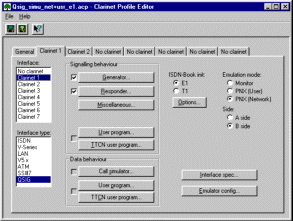|
|
|
Clarinet QSIG Application
Presentation
The Clarinet-system is a powerful Protocol Test
platform supporting QSIG interfaces and protocols. It offers a wide
variety of functions:
- Monitoring
- Automatic simulation
- Conformance testing for different layers of protocols based on
ETSI test suites
Standard covered:
|

Large snapshot
|
QSIG
|
Monitor |
Emulation |
Executable
Test Suites |
C-Programs
Simu |
Built-in
Simulation |
| Q921 |
x |
x |
ETS 300 402_7 |
x |
x |
| QSIG-Basic Call |
x |
x |
ETS 300 805_2 |
x |
x |
| QSIG-GFP |
x |
x |
ETS 300 806_2 |
x |
see
details |
Supp Services
ISO/ ECMA/ ETSI (ASN1) |
see
details |
|
|
|
|
|
| The flexibility and the user-friendly
interface of the software provides the user with a way to use it for
product development, engineering or field trials. |
Standard Features
Interface connection
Analysis Functions
Emulation functions
Signaling simulation
Programmable simulation
Conformance testing simulation
Clarinet-system: basic configuration
Physical Interface
- E1 75 or 120 Ohms
- T1 75 or 100 Ohms
Interface Management
- Simultaneous management on each interface
of three types of PH, SL, DL links:
- PH-physical interface: E1 or
T1 selection.
- Signaling link: definition of
the signaling channel (T1 or E1) for QSIG channel.
- Data link: automatic
B channel of BOP, BERT or BYTE-TS
type.
Protocol Event Generation
- Physical level: E1
and T1 alarms.
- Signaling link: QSIG channel HDLC frames.
- Data link: HDLC frames, BERT-G821 results
or BYTE-TS blocks.
- DTMF code.
Statistics Event Generation
- BOP type event counters on SL or DL.
- Data-flow counters on BOP link at
different protocol layers.
Protocol Specification for Display
- Physical Link: E1 TS0, T1, I430,
- Signaling Link:
- Data structure: BOP envelope.
- Decoding according to a protocol stack with 7 decoding
levels
- QSIG layer with full ASN1 decoding
- Data Link:
- Data structure: BOP envelope, BERT,
BYTE-TS.
- Decoding according to a protocol stack with 7 decoding
levels
QSIG Automatic Simulation:
Behavior: Generator (1 to 32 outgoing SETUP’s) and/or
responder (acceptance, 30 incoming SETUP’s).
- Independent outgoing communications
defined by:
- Delays and IE buffer for SETUP,
INFOS, RELEASE.
- Number of repetitions and
inter-communications delay.
- B channel establish and active
source.
- Identical incoming communications defined
by:
- ACCEPT/REJECT behavior.
- Transmission option and IE buffer
for SETUPACK, CALL-PROC, RELEASE.
- Delay before CONNECT.
- Establish and active source of
the B channel: default or
indication by USER INFO.
- Manual commands: CALL, CLEAR, INFO,
RESTART, etc..., DTMF values.
- Outgoing communications triggered by:
- Starting delay.
- Manual commands.
- Incoming communications (for 15
outgoing communications).
- Call simulator data sources:
- BOP Mode DL: X25 call simulator,
user program.
- DL Mode BERT: Pattern: 29 - 1
(V52), 211 - 1 (O152), 215 - 1
(O151), results according to
CCITT G821.
- DL Mode BYTE-TS.
- LOOP.
- External TRANSIT or TRANSDATA
links.
- COFIDEC 1 and 2 internal links on
analog sources: DTMF 1 and 2, HANDSET...
Physical Layer
- Emulation mode: PNX-User or PNX-Network .
Link Layer: Q921
- SAPI 0 initialization
- Setting of Parameters (time-limits, numbering)
Network Layer: QSIG
- Selection of variants (ISO/ETSI) and side (A/B) ,
- Setting of Parameters (time-limits, numbering...)
X25 Automatic Simulation:
- X25 automatic simulator can be run
in:
Frame Relay Automatic Simulation:
- Frame Relay automatic simulator
can be run in B channel
API
- Use of CLARINET-Development C language
- Microsoft format library.
- Level N simulation using emulation on signalling channel.
ETS
- Use of ETS packages resulting from TTCN compilation:
- Template of profiles, PICS/PIXIT
- Execution under Clarinet Run-time
ATS
- The Clarinet TTCN compiler and the stack of emulators allow the users to develop
or customize new ETS.
Qty
|
Refer.
|
Product Designation
|
1
|
2001
|
Clarinet-Book USB E1/T1
|
1
|
8001
|
Clarinet-Run-time
|
Clarinet-system: ISDN options
Qty
|
Refer.
|
Product Designation
|
1
|
8691
|
Clarinet-ETS-300 402_7 ISDN Data Link Layer
|
1
|
8521
|
Clarinet-ETS-300 805_2 QSIG Basic Call
|
1
|
8522
|
Clarinet-ETS-300 806_2 QSIG GFP
|
|
